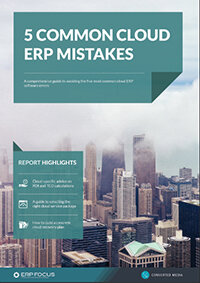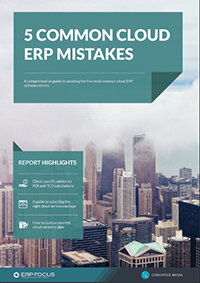How to prepare for your first cloud ERP implementation
Preparation for a cloud ERP implementation, also known as ‘system planning round’, represents a first-principle when if comes to any successful technical implementation. While there are some digital platforms that require little or no effort during a system spin-up, unfortunately the setup of an ERP system doesn’t happen to be one of them.
There are a host of reasons for this assertion, but most of them come down to the fact that user confidence must be paramount once an enterprise switch is flipped, and the system begins to wind around and through most, if not all, internal business processes. As a result, we thought we’d discuss some of the more critical prep steps in order to give you a better sense of what you’ll have to think about in the real world.
Here are the big five:
1. Soup-to-nuts process analysis
The implementation of a cloud ERP system offers an opportunity to catalog and investigate business processes from the ground up, since by their nature, these elements involve nearly every critical element within an enterprise. This step is an important way to make the relationship between a new virtual system and its business customer more effective. At the same time this step offers a clear opportunity to discard, alter and/or refine operational processes that may not be as useful as they might be, prior to migrating a company’s internal business infrastructure to a virtual environment.
Look at every process within each department in terms of value add. The classic question is whether your customer would pay for that process. If not, consider why it is done and whether it could be dropped or could you reduce the required resources.
Re-engineering processes before migration to a new ERP and incorporating an obsolete process should be considered now. Are there steps within the process that are redundant? Could two independent processes be combined and the total required time reduced? Could a required process be accomplished by personnel at a lower cost without affecting the quality of the process?
This might also be a good time to begin setting expectations. Users are excited to begin using the new ERP but if the implementation will take three months, some might need to ‘hold their horses’.
2. Set up an appropriate reporting structure
This planning step applies to enterprise reporting and how the company does and doesn’t utilize information made available by a new ERP. Legacy reports may be needed in the case of a new cloud system, so investigating this will offer a way to clear away some of the deadwood. However, since cloud ERP offers a direct advantage in terms of global transparency, the planner should also immediately prepare to expand his/her reporting catalog as an advantages emerge.
Review the stock reports that come with the new ERP. Many business needs remain constant and users can fulfill their needs with the same report in a new format.
The new ERP will have more sophisticated business analysis and reporting tools compared to any legacy system. Take full advantage of these. If a legacy report was used primarily to assist in decision making in a certain department, perhaps a better tool might be a dashboard on the computer screen that is updated in real-time considering all new transactions and provides a suggested action based on rules specific to that department and company policies
Guide: five common cloud ERP mistakes and how to avoid them
3. Conduct a security needs analysis
Given today’s data security climate, today’s ERP systems demand more rigorous requirements than previous iterations. Issues of data safeguarding, deeply-granular security protocols, and active and passive protection and recovery systems should be emplaced. In the case of cloud ERP specifically, pay attention to any security process/policy mismatches between your legacy platform and the cloud system you’re moving to; the latter typically involves baked-in security processes that may or may not be compliant.
Security is particularly critical with a cloud system. ERP data no longer resides in a protected server behind firewalls managed by the owners of that data. Cloud ERP systems can be hosted by the provider of the ERP. A business can also purchase their own ERP and have it hosted in a cloud managed by a third-party provider. Either way, the host should promise good security systems including backups, firewalls, and other protections. Most hosts do a good job but many have a hard time trusting outsiders.
There are also risks of down time. The host will promise a high rate of access and will notify a business in advance when most maintenance time will be needed. For most businesses, this is really no change from managing their own network which too needs maintenance and can go offline when the electricity is out for a while.
Many of today’s ERP systems can be run on a cell phone almost as well as on the computer at your desk. Consider developing mobile applications for these requirements that ensure limited mobile access while allowing necessary work to be done.
4. Cleanse any out-of-date or unwanted data
Initiating a clean ERP system offers a great way to investigate and re-validate one’s complete datastore, prior to migrating information from and old to a new cloud platform. This evolution may include mundane issues, such as removing obsolete records, or eliminating duplicate records, to more complex areas of focus such as data channel relationships between local to remote datastores. At the end of the day, the effort allows the at-large enterprise a chance to take a beat, and ensure that all data records and resolved information elements are entirely stable and ready to be migrated to the cloud.
Data can be dynamic, or transactional. The legacy system could have years of old data but often only the most recent year needs to be migrated. Keep the legacy system active but only on a read-only basis if old data needs to be read.
Static data are elements such as customer identifications and addresses. These will be required in the cloud system. Do not migrate former customers as they can be added later if they place a new order someday in the future.
5. Conduct an infrastructure analysis
While it may seem that all the planning power should apply to the cloud ERP platform itself, a company’s underlying legacy infrastructure should still be validated prior to implementation. Enterprise operators shouldn’t underestimate the importance of this setup since a virtually-hosted software system will only be as effective as the local environment allows.
Operating a cloud-based ERP will require internet access that is fast and has sufficient bandwidth to allow all the users within the business to connect and continue their work satisfactorily. That internet access should be available throughout the workday with few interruptions. Consider whether to employ a second internet provider as a backup. Look for connection security that prevents outside access that should be prohibited and be sure to remove access to former users quickly.
Granted, there a number of other more important focus areas regarding this kind of planning round, but ‘The Big Five’ should get you started on a fair degree of confidence. Nevertheless, the end-goal of all processes must be oriented to ‘what the enterprise wants’ at a business level; not ‘what the salesperson would like’. So if you’re mindful of that caveat alone you’ll be a long down the road of getting the system you want, when you want it, and how it behaves once you spool up for the first time.
Free white paper

Five common cloud ERP mistakes
Get your comprehensive guide to avoiding the five most common cloud ERP errors

Featured white papers
-

ERP Implementation: 9 steps to success
The 9 proven steps you should follow when implementing ERP
Download -

ERP Implementation Checklist
Over 120 actionable steps to implementing a new ERP successfully
Download -

Manufacturing ERP Implementation Checklist
Over 70 actionable steps to rolling out new manufacturing ERP software
Download
Related articles
-

The case for multi-tier ERP implementations
Learn more about multi-tier ERP implementation and why you might need one
-

Secret KPI: Why Your ERP Implementation Team Matters More Than Software
Learn how Godlan ensures successful ERP implementation for manufacturers with proven strategies &...
-

An example ERP implementation team structure for your project
Learn about three key elements of an ERP implementation team and the individuals who contribute w...

